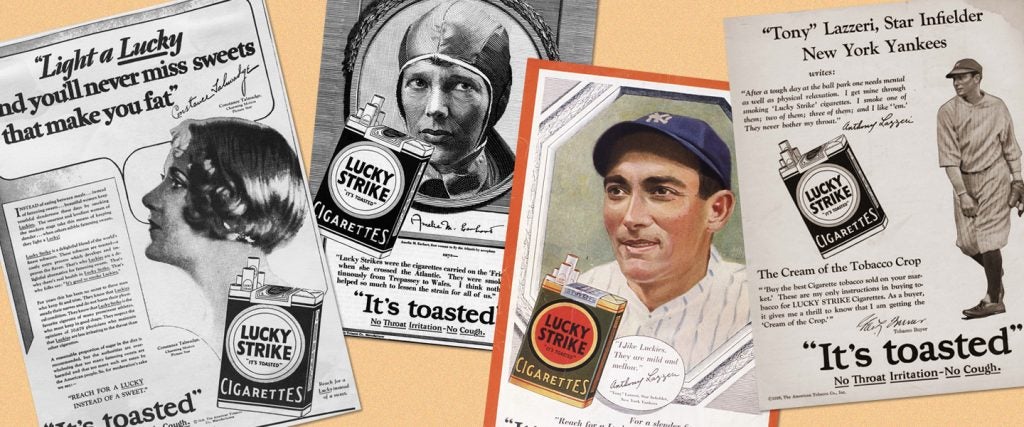Like Big Tobacco itself, Lucky Strike is infamous for many things, but it’s perhaps most infamous for the “Lucky Strike Diet,” or the marketing campaign in which it insinuated that smoking would help you lose weight. “Reach for a Lucky and not for a sweet,” actress Fannie Ward recommended.
Similarly, fashion designer Paul Poiret claimed that there was some unknown quality of Lucky Strikes “that satisfies the cravings for rich things that add weight.” (We now understand that the highly addictive nicotine within the Lucky Strikes activates an appetite-suppressing pathway in the brain.)
But amazingly, this was far from the most shameless celebrity-endorsed claim Lucky Strike offered up back in the 1920s and 1930s. There was also…
Lucky Strikes Won’t Touch Your Gains
British dancing duo Marjorie Moss and Georges Fontana declared that Lucky Strikes never affected their “wind or physical fitness in any way.” Not only is this statement farcical on its face, as smoking limits the capacity of oxygen to reach the heart, lungs and muscles, but Moss was diagnosed with tuberculosis within three years of this ad’s first appearance, and subsequently died in 1935 at the age of 42. Sadly, studies have conclusively demonstrated that smoking increases the likelihood of a person contracting tuberculosis, worsens any existing tuberculosis symptoms and lessens the favorability of responses to tuberculosis treatment.
Another ad from the era suggesting that Lucky Strikes never interfered with the performance of professional athletes included Pittsburgh Pirates legend Paul Waner while he was in his baseball-playing prime at the age of 25. Waner passed away in 1965 at the age of 62 following a surgery to ease the suffering caused by chronic respiratory illness.
Lucky Strikes Are Easy on the Throat
Lucky Strike ads also went overboard to suggest that it was impossible for their cigarettes to cause any form of throat irritation. To hammer this point home, they enlisted famous singers and vocalists like Antonio Scotti and Ernestine Schuman-Heink. But just eight years after her ad hit the presses, Schuman-Heink died from leukemia, another disease cigarette smoking has been linked with. Over a similar time horizon, Scotti began noticeably suffering from a clear loss of his vocal prowess, as if some mysterious force had begun to rapidly eat away at his throat. He lost his place on the Metropolitan Opera’s roster in 1933 and died in poverty in 1936.
Lucky Strikes Will Turn You into a War Hero
An ad from 1930 featured Brigadier General Walter Clark Montgomery, who commended Lucky Strike in print for creating a cigarette that was purportedly less irritating to “the delicate nose and throat membranes.”
Even more shocking was the next advertisement featuring a military man. Count Felix von Luckner of Germany — an officer who commandeered the disguised sailing vessel SMS Seeadler, and whose orders led to the sinking of 16 Allied ships, three of which were American — appeared as a spokesperson to hawk Lucky Strikes to American consumers. Luckner’s seafaring exploits were lauded for their relatively low body counts, which was one of the reasons for his international fame following World War I. It was probably a bit awkward for both Luckner and Lucky Strike, however, when the Nazis trotted him out 15 years later to negotiate the surrender of the German town of Halle during the final days of World War II.
Lucky Strikes Were the Original Feminist Ally
Okay, stay with me here: Another ad educated the reader as to the critical role Lucky Strikes had played in bringing women into the important discussions percolating around the dinner tables of American homes. The illustrations juxtaposed the supposed egalitarianism of the 1920s with exclusionary acts committed by Native American tribes against their own women. That’s right, the copywriter shamelessly leaned into prejudice against Native Americans to hamfistedly underscore how Lucky Strike had helped to reduce prejudice against American women.
One Last Drag
Certainly this is all very comical to review. In fact, it’s so easy to poke fun at, that it can easily slip your mind that cigarette smoking is still responsible for an estimated 480,000 deaths each year in the U.S. alone. This is a high number any which way you look at it, but it’s particularly high when you consider that cigarette ads began to slowly fade into obscurity beginning in the early 1970s, and no modern celebrity would risk their likeness being placed within second-hand smoking distance of such a campaign.
It’s also very much a testament, though, to 1) how addictive nicotine is; and 2) how effective these early ads were. Because they secured a consumer base that even a century later is still puffing away.

